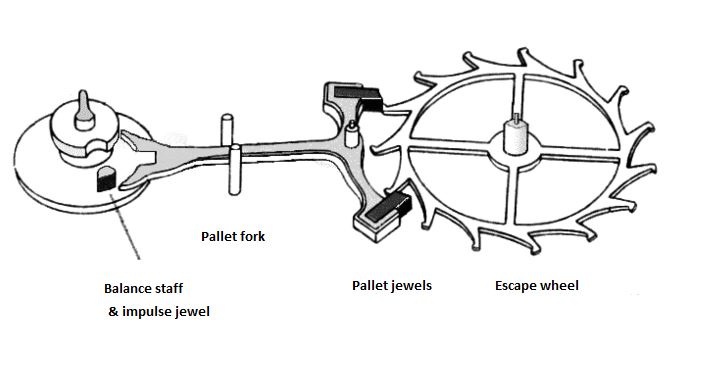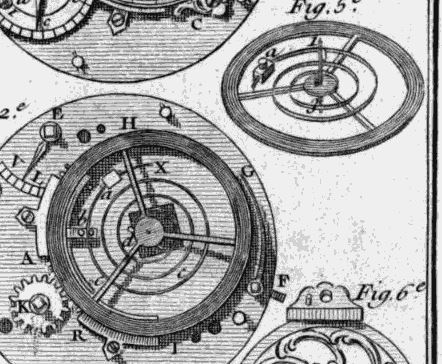The balance wheel, combined with the hairspring, is the critical timekeeping component of the movement. It forms an oscillator that controls the release of power from the mainspring barrel and therefore the timekeeping of the watch. The balance wheel has a central arm that is mounted on the balance staff and carries a circular rim that is the oscillating mass.
The hairspring is mounted above the balance. It is secured to the balance cock at its outer end by the stud. Its inner end is secured to the balance staff by the collet. The hairspring is constantly trying to hold the balance wheel in one central position. If the balance is moved from that central position in either direction, the spring pulls it back. A regulator lever is often fitted to the balance cock. This can be used to alter the free length of the spring and thereby adjust the rate of the timepiece.
The balance is so-called because in early clocks there was no circular rim. The balance was a single central bar or arm with weights hanging from it to provide the mass. These weights were adjusted to control the timekeeping. The mechanism looked like a weighing balance on a set of scales, hence the name balance.
The balance cycle
As the balance swings back and forth, a small impulse jewel knocks the lever from one side to the other. Each time this happens, the pallet jewel which is currently locking the escape wheel is released. This allows one tooth of the escape wheel to escape. The other pallet jewel then locks with the escape wheel. As such, each time that the balance wheel swings, the escape wheel advances one tooth. Immediately after the locking pallet jewel has released a tooth of the escape wheel, the escape wheel gives the pallet jewel a push, which in turn makes the lever give a push to the balance wheel through the impulse pin. This push or impulse, as it is called, is what keeps the balance swinging backwards and forwards.

Once the balance has knocked the lever it carries on turning as far as its momentum and the little extra push it received from unlocking the escape wheel will take it against the resistance of the hairspring. When the balance has run out of energy it pauses and then the hairspring accelerates it in the reverse direction. In passing it knocks the lever back the other way, and the cycle starts all over again.

Period of oscillation
Each swing in a single direction of a balance wheel is referred to as a beat. A complete cycle, or period of oscillation, consists of two beats, one in each direction. Each beat represents a tick and the forward movement of the hands. These beats are happening so quickly it is barely noticeable to the naked eye. The sweeping second hand of a mechanical watch is actually an optical illusion. The balance wheel is ticking or beating around 5 beats per second (18,000 BPH). The second hand ticks forward for each of these beats, that is 5 times a second, this creates the appearance that the hand is actually sweeping forward.

Temperature
The balance wheels and hairspring are both highly susceptible to changes in temperature. Early watches had hairsprings made of plain steel and balances of brass or steel, and the influence of temperature on these noticeably affected the rate. For example, an increase in temperature causes the dimensions of the hairspring and the balance to expand. The effect on a hairspring made of plain steel is that the elasticity of the spring decreases significantly as the temperature increases. This results in a weaker spring with increasing temperature.
An increase in temperature also increases the diameter of the balance wheel, increasing its rotational inertia. This makes it harder for the hairspring to accelerate the balance wheel. A weaker hairspring and the increased inertia of the balance wheel combine to slow down the number of beats and the watch loses time. The opposite occurs with colder temperatures. These issues were gradually compensated for by using different alloys and materials that were more resistant to changes in temperature. These temperature adjusted movements are accurate to within just a few seconds a day.
Related content
Read more about other Movement types and Components.
